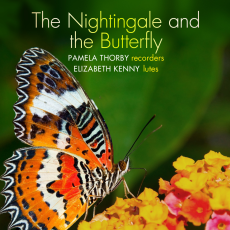The Nightingale and the Butterfly - Pamela Thorby & Elizabeth Kenny - The Consort
This is a CD of musicby French baroque composers, recorded at the National Centre for Early Music,York, by two expert soloists, Pamela Thorby and Elizabeth Kenny: a suite byLouis Caix Dd'Hervelois (1680-1759) played on soprano recorder in C andarchlute; two suites by Charles Dieupart (c1667-c1740), the first played ontenor recorder in D with theorbo accompaniment, and the second played onsoprano recorder in B flat, with archlute. There is a sonata by Anne-Dannican Philidor(1681-1728) played on alto recorder in F and theorbo, and Elizabeth Kenny playssome fine solos on the theorbo by Robert de Visée (c1650-1725): a Passacaille and a Suite in D minor from the Vaudry de Saizenay manuscript.
Thesurviving solo repertoire by French baroque composers is of a high quality,demanding both precision and freedom. There are soaring melodies and gracefuldances, yet their performance directions are recorded in meticulous detail. AsElizabeth Kenny writes in the sleeve notes: ‘It's music to play by feel ratherthan precept, which is why it's an entertaining paradox that it comes giftwrapped in tightly-ordered treatises on everything from fingering toornamentation'.
Themusic is memorable, and is beautifully performed. The two suites by Dieupartwere first published for solo keyboard in 1701; they were copied by J S Bach,as models to study. In the following year they were re-issued for recorder. Wecan imagine Robert de Visée's pieces, played here with great depth andvariety of tone by Elizabeth Kenny, being performed by royal command, late atnight, in Louis XIV's bedchamber: in particular, the Sarabande from the suitein D minor (track 24) would have soothed royal ears, and eased them intopeaceful sleep.
PamelaThorby is perhaps Britain's most stylish and creative recorder virtuoso, whonow features in ten albums by Linn Records. All her playing is beautiful tolisten to; my favourite tracks are the fourth movement of Philidor's sonata,entitled Les notes inégaleset détaches(track 12), and the fourthmovement of Deuxième Suite in G major by d'Hervelois, entitled Papillon,‘The butterfly' (track 4. In this charming gavotte, Pamela conveys abutterfly's fluttering wings with exquisite delicacy.
Thorbyalso performs two pieces entitled LeRossignol-en-amour, ‘The love-sick nightingale' (track 27), and Le Rossignol Vainqueur, ‘The victoriousnightingale' (track 35), accompanied on the 5-course baroque guitar. These twomovements are taken from Couperin's TroisièmeLivres de pièces de clavecin, Quatorzième Ordre. Although the Ordre is for keyboard, Couperin suggeststhat the upper line of Rossignol-en-amourbe played on the flute.
Manyreaders of The Consort will befamiliar with these two pieces from the delightful recording of Carl Dolmetschperforming them on sopranino recorder, accompanied by Joseph Saxby on theharpsichord. I have to admit that I prefer this earlier recording: the baroqueguitar does not equal Saxby's delicate harpsichord accompaniment, and Le Rossignol Vainqueur loses some ofit's nightingale charm when performed by Thorby on the lower tenor recorder inD, which does not match the timbre of the other movement, whose Double is unaccountably held over untiltrack 36, at the end of the CD. This reservation apart, lovers of Frenchbaroque music will find plenty of rich fare on this CD.


